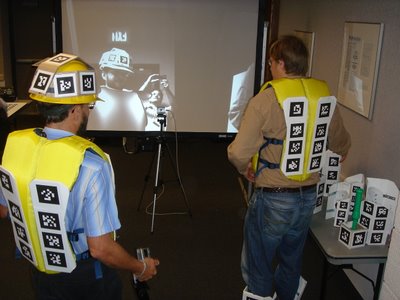
The IEEE ISMAR conference (International Symposium on Mixed and Augmented Reality) is the annual meeting of researchers who work in the domain of Augmented and Mixed Reality. Its current schedule is to be held every two years in the US, then in between once in Europe, then in Japan. In the last year, ISMAR 2005 was held in Vienna, and this year it was in Santa Barbara, California, hosted by University of California at Santa Barbara (UCSB), from 22. - 25. October 2006.
I have been active in the steering committee of this conference since its beginning in 1998 when it started as a simple workshop (IWAR 98). This conference provided the opportunity to meet again familiar faces and also get acquainted to new players in this field.
For the 2006 ISMAR meeting, 105 papers had been submitted (including posters: 117). During a weekend session of the program committee (which had been held in June 2006 in Los Angeles) where I attended as area chair, 30 papers were selected for acceptance, which translates to an acceptance rate of 29%. Printed Proceedings and a CD with the papers were given to attendees. The conference details, including the program, can be access at the conference web site at http://www.ismar06.org/.
The overall statistical data are as follows: there were 15 papers from Europe, 7 from America, 8 from Asia/Pacific. 15 posters, 2 keynotes, 2 demo sessions, 2 tutorials, and 2 workshops were included in the program. The whole conference was organized in a single track, so it was possible to attend each presentation. A total of 160 attendees were registered.
The meeting venue was the Corwin Pavillon at University of California at Santa Barbara (UCSB). The 2006 ISMAR general chair was Prof. Tobias Hoellerer (UCSB), whom I have known since his PhD work at Columbia University with Steven Feiner back in 1997.
Two workshops were held on the Sunday before conference: Industrial Augmented Reality, and the Workshop on Mixed Reality in Fim Making. In addtion, there were tutorials for Computer Vision for Augmented Reality, Head-Worn Displays: Fundamentals and Applications, and a Student Research Colloquium.
I attended the workshop on film making. 9 papers were presented, including a keynote by Paul Devebec (USC). Mixed Reality (MR) can be a useful tool in pre-visualisation, before expensive movie scenes are being filmed. In TV, MR is being used with Chroma-key techniques to merge real sceneries with graphical information, or with placing the actors into sceneries outside the studio environment.
On Monday, the conference started with a keynote talk “The Poor Man’s Palace: Special Effects in the Real World” by Ramesh Raskar from MERL (Mitsubishi Research Lab). The last time I had seen him was at the very first IWAR workshop in 1998, which was the predecessor of the ISMAR conference. Ramesh presented his vision of applying special effects in the real world, by projecting graphics into the real environment. He also demonstrated a product from Mitsubishi: the Mitsubishi Pocket Projector, a miniature projecting system. In addition he discussed the use of photo-sensing RFID tag which could emit their information triggered by coded light.
A 2nd keynote was given on Wednesday by Prof. Tom Furness (University of Washington, Seattle). I have known Tom since 1998 due to collaborations in a US project on augmented reality. Instead of the originally planned topic on AR technology, he decided to give his presentation a personal touch: “My attempts to save the world”. First he started with his work for the US Air force in developing helmet-mounted displays for fighter airplane cockpits (1967). This work led to making a headset for dentist’ patients, distracting them from the dentistry work done on them. In 1989 he moved to U. Washington to found the Human Interface Technology Laboratory (HitLab) – in mid 2007 a new HITLab will be started in New Zealand . He co-founded Virtual Vision (now eMagin, Inc.), a company working on such head-worn displays. After developing the "Virtual Retinal Display", a new problem has been addressed: to provide true stereo displays, not just based on dual-eye disparity, but also on single eye accommodation: the wave front of the light is manipulated, simulating depth. He further got involved in using Virtual Reality (VR) for learning, working on the Puget Sound Cruise, a system for interactive learning about nature. He also is involved in PARVAC, the Pacific Rim visualization center for visualizing natural threats and disasters. The technology of “low vision” is used in helping the blind to improve eye sight. In his talk, he made a passionate plea for peace and against war. He finally proposed the founding of a “Virtual World Society”, with $30 membership per year, to help developing educational games.
The individual sessions dealt with applications of AR, tracking, AR user interfaces, mobile tracking, mobile user interfaces, evaluations, calibration and resutrasion, multimodal AR, and visualisation. There were also sessions with 21 demonstrations and 15 posters.


The progress on tracking, which is a very important subject for Augmented Reality, had been significant – basically visual tracking can be considered as being solved, except for specific cases and lighting conditions.
In general, in the US the interest in the technology of Mixed and Augmented Reality has slowly faded over the past years, whereas in Europe and Asia the technology still is quite actively pursued. This may lead to ISMAR being no longer held every 2 years in the US.
No comments:
Post a Comment